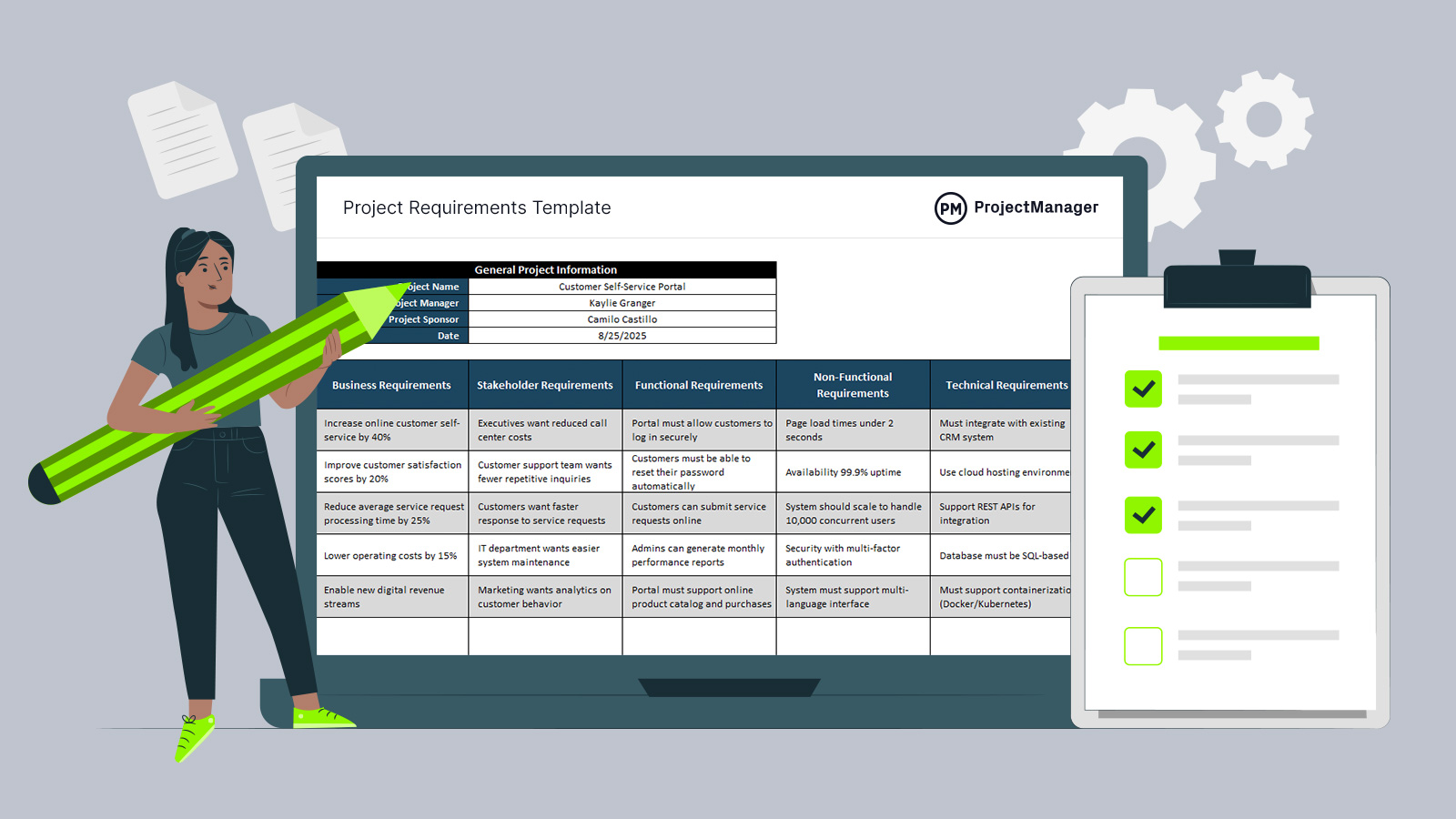A project requirements template provides a simple and organized way to capture the essential needs of a project before work begins. Using a structured format in Excel helps ensure all critical details are documented, from scope and objectives to functional and non-functional requirements. This prevents confusion later in the project and sets a solid foundation for planning and execution.
By downloading a project requirements template, teams can save time and focus on defining deliverables, stakeholders and success criteria. Excel makes it easy to edit, share and update requirements as the project evolves, keeping everyone aligned on what needs to be delivered and how progress will be measured.
While a project requirements template is a great starting point, project management software is far more powerful. Templates require manual updates and lack automation, real-time collaboration and reporting capabilities. Software eliminates version control issues and centralizes all project data in one accessible platform.
ProjectManager is the ideal solution for managing requirements, planning schedules and tracking progress. Its interactive Gantt charts make it easy to map dependencies, set baselines and monitor changes in real time. With additional tools for resource management, workflow automation and reporting, it goes far beyond what a static template can provide. Get started with ProjectManager today for free
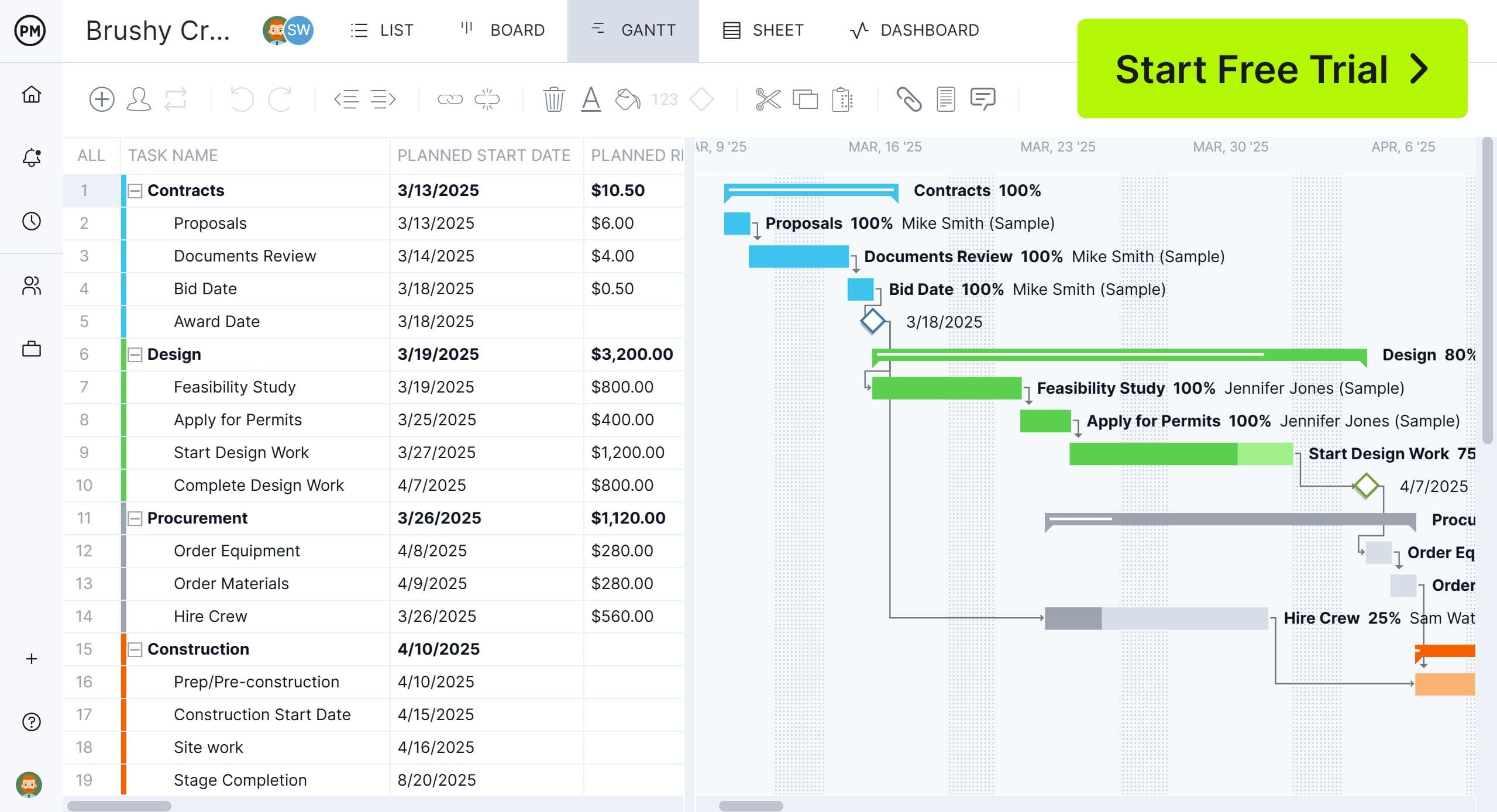
Why You Need a Project Requirements Template
A project requirements template is essential for ensuring all project needs are clearly defined before work begins. It helps teams document goals, scope, deliverables and constraints in one organized file. This prevents miscommunication, reduces scope creep and provides a reference point throughout the project. Without a well-prepared requirements template, key details may be overlooked, leading to costly delays and rework.
Another reason to use a project requirements template is its ability to bring clarity and alignment across stakeholders. By outlining functional and non-functional requirements, teams can identify priorities, dependencies and potential risks early in the process. This structured approach sets expectations and provides a foundation for scheduling, budgeting and resource allocation.
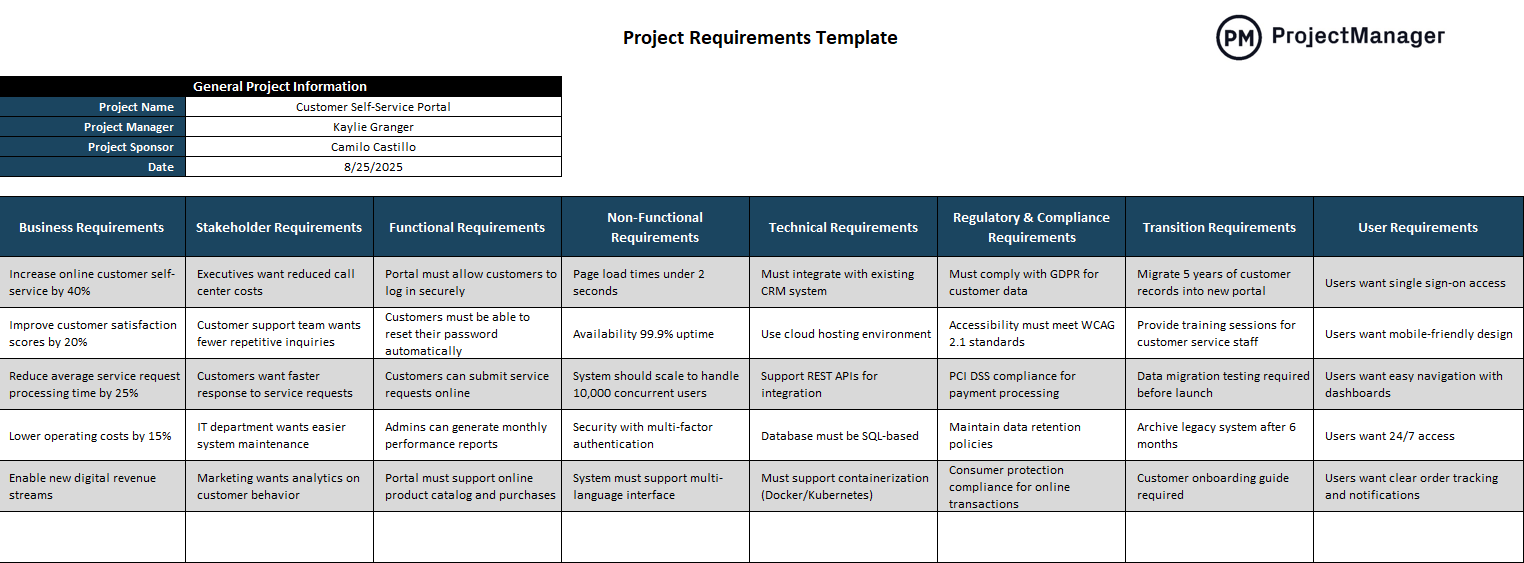
When to Use a Project Requirements Template
Use a project requirements template at the start of the project planning phase when defining objectives, scope and deliverables. It’s especially useful before creating schedules, budgets or assigning resources because it captures all essential details that guide these next steps.
It’s also valuable when onboarding new stakeholders or team members since it provides a single reference document that ensures alignment. Any time a project has multiple departments, external vendors or strict compliance needs, a project requirements template helps prevent misunderstandings and keeps everyone focused on the same goals.
Who Should Use This Free Project Requirements Template?
This free project requirements template is designed for project managers, team leads and coordinators who need to define deliverables before work begins. It also works well for business analysts and product managers who must translate stakeholder needs into actionable plans.
Consultants, contractors and agencies can use it to set expectations with clients and avoid scope creep. Even executive stakeholders benefit, as the template provides a structured view of objectives, priorities and constraints before approving budgets and schedules.
How to Use This Project Requirements Template for Excel
Use this project requirements template for Excel as the single source of truth when documenting what a project must deliver. The attached workbook contains labeled sheets and preformatted fields to capture scope, stakeholders, constraints and acceptance criteria.
Start by saving a copy, then fill each section in order so the information flows from general context to detailed technical needs. Keeping the template updated and shared with stakeholders reduces misunderstandings and speeds approval and handoff.
1. General Project Information
Begin by populating the General Project Information sheet in the attached project requirements template. Include the project name, sponsor, project manager, start and target completion dates, version number and a brief project summary. Add business unit and key contact details so readers know who to engage for clarifications.
This header information anchors the rest of the document, helping reviewers understand scope context, timeline expectations and who to hold accountable for approvals and decisions throughout the project lifecycle.

2. Business Requirements
Use the Business Requirements section to capture the high-level goals this project must achieve. Describe the business problems being solved, the expected outcomes and how success will be measured. Link requirements to strategic objectives and note any quantitative targets such as revenue increases, cost reductions or efficiency gains.
This part of the project requirements template sets the rationale for investment and guides prioritization so technical and functional work aligns with measurable business value.
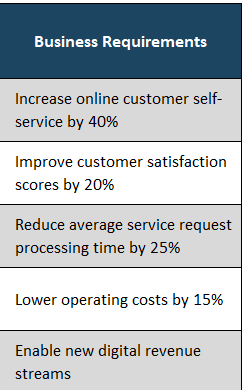
3. Stakeholder Requirements
Document stakeholder requirements by listing stakeholder groups, individual roles and the specific needs or expectations of each. Note communication preferences, reporting cadence and approval responsibilities so engagement is consistent. Capture constraints stakeholders impose, such as budget limits or timing windows.
Use the attached template to tie each stakeholder to particular deliverables or acceptance criteria, establishing ownership. This reduces rework and ensures design decisions reflect the priorities of those who will use or fund the solution.

4. Functional Requirements
In the Functional Requirements sheet, describe the system behaviors, features and user interactions the project must provide. Write clear, actionable statements such as “the system shall allow users to submit orders” or “the report shall export to Excel.”
Group features by user role or module to keep the project requirements template organized. Include acceptance criteria for each function so testers know how to verify completion and stakeholders can sign off on whether delivered features meet expectations.
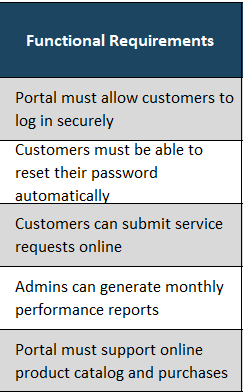
5. Non-Functional Requirements
Non-functional requirements define quality attributes for the solution, such as performance, security, scalability and availability. Use the template to specify response time targets, throughput limits, uptime SLAs and encryption or authentication needs. These criteria influence architecture choices, testing plans and operational readiness.
Make the requirements measurable where possible, for example, “system response time shall be under two seconds for searches,” so the delivery team can validate compliance before handoff to operations and end users.

6. Technical Requirements
Record the technical requirements that support functional needs, including platforms, databases, middleware integrations and supported browsers or devices. Note preferred languages, frameworks and any version constraints or vendor approvals required. Include interfaces to external systems APIs, data formats and authentication methods.
Use the project requirements template to link technical items to functional features so engineers can size work, identify dependencies and plan development environments and deployment pipelines effectively.
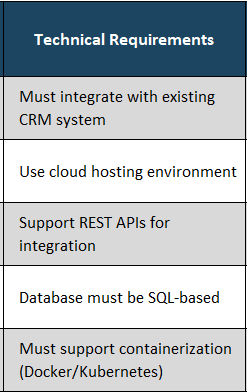
7. Regulatory & Compliance Requirements
Capture all regulatory constraints and compliance obligations relevant to the project, such as data protection rules, industry standards or audit requirements. Specify retention periods, encryption requirements, reporting obligations and any certification timelines.
Use the project requirements template to list applicable laws and responsible owners for compliance tasks. Documenting these needs early prevents costly changes later and ensures the solution meets legal and contractual obligations before it is released to customers or internal users.
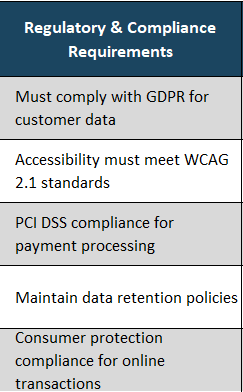
8. Transition Requirements
Transition requirements cover what is needed to move from project delivery to steady state operations. Include training plans, documentation, handover checklists, support models and rollback procedures. Specify data migration steps, conversion rules, cutover windows and any parallel run requirements.
Use the template to assign responsibilities and a timeline for each transition activity so operations teams are ready to accept the solution, users are trained and business continuity risks are minimized.
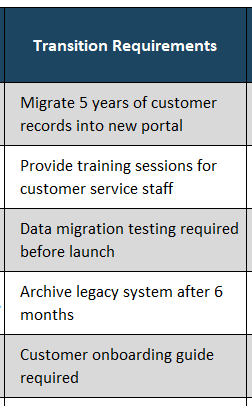
9. User Requirements
User requirements should capture user personas, tasks and usability expectations that drive design decisions. Describe primary workflows, typical scenarios and edge cases users will face. Include accessibility considerations, user permission levels and any personalization needs.
Where applicable, add screen sketches, wireframes or links to mockups in the attachment to illustrate flows. Clear user requirements in the project requirements template help designers and developers build intuitive interfaces that meet real user needs and reduce rework from usability issues.

Related Project Management Templates
Managing projects effectively requires the right tools to document progress, track requirements and communicate outcomes. Beyond a project requirements template, these related project management templates provide structured ways to review completed work, ensure alignment with stakeholder expectations and report status to decision-makers. Each one supports a different stage of the project lifecycle while helping teams stay on track and maintain transparency with all involved.
Project Review Template
Download this free project review template to help teams capture lessons learned, performance metrics and overall outcomes at the end of a project or key milestone. It provides a framework for assessing what worked, what didn’t and how future projects can benefit from the insights gained. Use it to improve processes and build institutional knowledge for better results over time.
Requirements Traceability Matrix Template
Use this free requirements traceability matrix template to ensure that every project requirement is linked to a deliverable and verified through testing. It helps maintain alignment between stakeholder expectations and final outputs, reducing missed functionality or scope creep. This tool is essential for projects with strict compliance or validation needs.
Project Status Report Template
This free project status report template provides a clear, structured format for updating stakeholders on progress, risks, budget and schedule performance. It simplifies reporting by organizing data into key sections for quick review, helping decision-makers stay informed and address issues before they escalate.
How to Manage Projects with ProjectManager
While a template provides a static framework, ProjectManager offers dynamic tools that simplify complex workflows and improve collaboration. Multiple project views let teams manage work the way they prefer, from task lists for simple to-dos to kanban boards for agile workflows and calendars for deadline tracking. This flexibility helps teams adapt quickly, ensuring tasks, milestones and deliverables stay aligned with project goals.
Optimize Resource Management
ProjectManager makes it easy to allocate resources efficiently with features like real-time availability tracking, a color-coded workload chart and a dedicated team page. These tools help balance assignments, avoid overloading individuals and ensure everyone is working at capacity without burnout. Managers can reassign tasks or adjust timelines instantly to keep schedules realistic and teams productive.
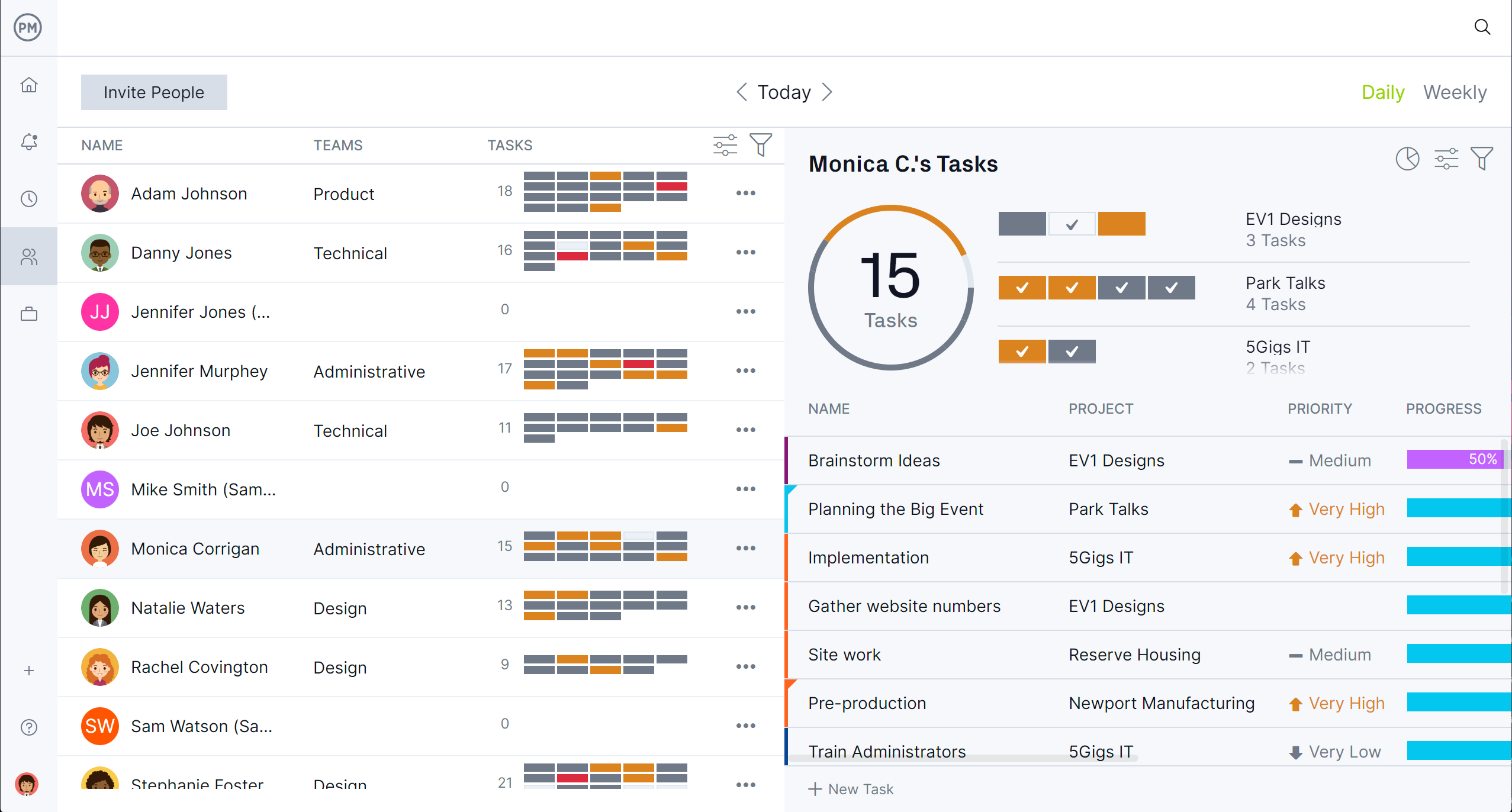
Track Performance in Real Time
With ProjectManager, tracking progress goes beyond simple updates. Real-time project and portfolio dashboards display key metrics at a glance, while customizable reports provide deeper insights for stakeholders. Secure timesheets ensure accurate labor tracking and compliance, helping teams monitor costs, measure performance and make data-driven decisions throughout the project lifecycle.

Related Project Requirements Management Content
For those who want to learn more about project requirements management beyond a project requirements template, check out the links below. They lead to articles on the process, documentation and management of project requirements.
- Requirements Gathering: The Process, Best Tools & More
- How to Write a Business Requirements Document (BRD)
- Project Requirements Management: A Quick Guide
ProjectManager is online project and portfolio management software that connects teams, whether they’re in the office or out in the field. They can share files, comment at the task level and stay up to date with email and in-app notifications. Join teams at Avis, Nestle and Siemens who are using our software to deliver successful projects. Get started with ProjectManager today for free.
